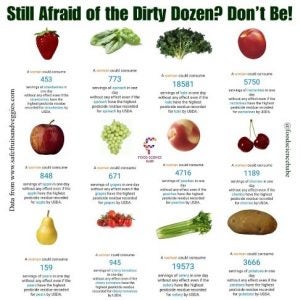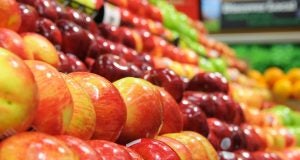If you haven’t heard of the Environmental Working Group (EWG) and their annual “Dirty Dozen” and “Clean Fifteen” lists by now, consider yourself lucky. For those that have heard of these lists that are published each spring, you may wonder if we really need to worry about “dirty” food. Are there “toxic pesticides” on our foods as the EWG wants you to believe? Well, not exactly. If you’ve been following my page for any length of time you know by now that the phrase “toxic pesticides” in and of itself is a nonsense term. “The dose makes the toxin” applies to all pesticides, even the ones used in organic farming, and yes, despite what the EWG may lead you to believe, organic farming uses pesticides, too.
First, just a bit of a background on the EWG. They seem like an unbiased, legitimate organization … until you start to do a little digging. They are largely funded by the organic industry with ties to the likes of Organic Valley, Stonyfield Farm, and Earthbound Farms, just to name a few. Their board members include one of most well-known charlatans, Dr. Mark Hyman, who sells dietary supplements and detox products and recently made the ridiculous claim that 75 percent of Americans are “carbohydrate intolerant.”
So, if you think that EWG is simply an unbiased organization that does what’s best for consumers, that couldn’t be further from the truth. They are highly biased, and their information is not at all evidence-based.
Every year scientists from the USDA visit commercial food channels and collect more than 10,000 food samples. The Pesticide Data Program (PDP) manages the sampling, testing and reporting of pesticide residues on a wide variety of domestic and imported foods using a sound statistical program. The pesticide data that the USDA publishes each year provide regulators, scientists, registrants, farmers, processors, and consumers with important insights into the actual levels of pesticide residues found on widely consumed foods. The Environmental Protection Agency (EPA) uses PDP data to conduct dietary risk assessments and to ensure that any pesticide residues in foods remain at safe levels. This data shows us year after year how incredibly safe our food is from a pesticide residue perspective. In 2018, over 99 percent of the samples tested had residues well below the tolerances established by the EPA with 47.8 percent having no detectable pesticide residue at all. In fact, the residues are so incredibly low (parts per BILLION levels) that we’d essentially have to eat a toxic level of any of these foods before even reaching a level in which the pesticide residues may have negative effects.
The Alliance for Food and Farming (AFF) put together a calculator that shows just how many servings of each of the foods included on EWG’s Dirty Dozen a man, woman, teen, or child would have to consume before reaching the No Adverse Effects Level (NOAEL) of pesticides based on the highest pesticide residue recorded for that food by the USDA. Here are the results for the foods listed on this year’s “Dirty Dozen” based on an adult female:

Despite this data consistently showing how safe our food is, the EWG manipulates this very data to scare consumers about perfectly safe conventional foods. They publish their list every spring and recommend that people purchase organic versions of these fruits and vegetables because they claim that they are “cleaner” and have less pesticide residues. However, what they do in their “analysis” is take the USDA PDP data and just count the number of pesticide residues on each type of food. That’s it. The list is made up based on the total number of different pesticides detected on each food. They completely disregard what the chemical is, at what concentration it occurs on the food and how that compares to the crop-chemical-specific EPA tolerance levels. They also don’t ever mention that fact that organic farming uses pesticides, too, and that the organic versions of these foods have similar ppb levels of pesticide residues. In addition to that, they leave out the fact that the USDA PDP is not set up to be able to detect most of the organic-approved pesticides because it would require expensive and specific assays. Only the organic-approved fermentation product, Spinosad, is detected by the methods used. Thus, the PDP does not show us a complete picture, however, it does show us that our produce supply is very safe from a pesticide residue perspective.
The USDA included raisins in its most recent PDP testing, and according to the EWG, “the results are shocking!” They earned the No. 1 spot on the Dirty Dozen list this year, but do you know what the most shocking thing is? In some cases, there were no differences between organic and conventional raisins. A couple of pesticides that aren’t even allowed in organic farming were detected about as often, at comparable levels, on both conventional and organic raisins. Don’t go throwing out your raisins just yet. The story is still the same as it is for all of the foods on their deceptive lists. The residues are at such low levels that a 20kg (44-pound) child would have to eat over 400 servings of raisins PER DAY to reach a level that may have negative effects. That’s more than 100 cups PER DAY! I think you’d have issues with the raisins themselves long before then.
This is the case year after year. The PDP annual summaries consistently show that 99 percent of sampled products have residues well below EPA tolerances, which are set based on an extensive and rigorous risk assessment reflecting all the toxicological information available. The EWG then takes that data and ranks the foods based on a metric that has absolutely nothing to do with the safety of the food. Year after year the data also shows that a small number of synthetic pesticide residues not allowed in organic farming are detected on most organic crops as shown in this analysis by PhD Plant Pathologist Steven Savage. The other shocking part is that there is an allowance in the USDA Organic Program rules stating that if a synthetic pesticide residue is detected on an organic product, if the level is 5 percent or less of the EPA tolerance, it is considered “unintentional” and thus not a violation of the organic certification standard. In this analysis of the 2017 PDP data by Dr. Savage, he shows that 99.2 percent of the organic samples from the U.S. and 98.4 percent of the organic imports would have met the 5 percent or less standard. What is so shocking and goes against the EWG’s narrative is that 96.3 percent of the conventional samples from the U.S. and 94.1 percent of the imported conventional samples would also “qualify” if they had been organic samples being tested for compliance. Year after year the PDP data demonstrate that pesticide residues found on foods tested are detected at levels well below the EPA tolerances and pose no safety concern. Consumers should feel confident about eating a diet that is rich in fresh fruits and vegetables.

So, at best, these lists that the EWG puts out every year are just incredibly deceptive and cause people to spend more money on organic produce due to unnecessary fears of conventional foods. A recent study showed that fear-based messaging regarding pesticide residues resulted in low income consumers stating they were less like to purchase any produce — organic or conventional.
This year in particular the EWG’s fear-based messaging could cause even more harm as they decided to release their lists amid the coronavirus (COVID-19) pandemic. This decision was incredibly tone deaf considering the fact that we have legitimate things to worry about right now. Not only that, but our grocery stores are already scarce, so scaring consumers over conventional produce, which may be the only option available to them right now, could cause them to just skip buying fruits and veggies all together. The worst case scenario is that it could cause consumers to toss their synthetic produce that they have at home and make an extra trip to the grocery store, which puts them at risk of contracting COVID-19. So, either way you slice it, their lists are doing nothing but harm
I think it’s time that the EWG really needs to reflect on the harm they are causing. Fear sells, and they’re making a lot of money from it, so we can’t expect them to change. However, we as consumers can change, and we can stop letting shady, biased and completely non-evidence based organizations determine our purchasing behavior. #DoBetterEWG, but since they probably won’t, lets all #StandUpForScience and shop based on #FactsNotFear.
Food Science Babe is the pseudonym of an agvocate and writer who focuses specifically on the science behind our food. She has a degree in chemical engineering and has worked in the food industry for more than decade, both in the conventional and in the natural/organic sectors.



